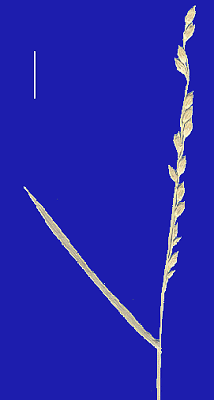 |
 |
|
 |
 |
|

Brachiaria ramosa (L.) Stapf |
Derivation
Brachiaria (Trin.) Griseb., in C.F. von Ledebour, Fl. Ross. 4:
469 (1853). From the Latin brachium (arm), alluding to the manner of
bearing the racemes.
ramosa- from the Latin ramus (branch) and -osa (abundance). Inflorescence or culms much branched.
Published in
Fl. Trop. Afr. 9: 542 (1919).
Common synonyms
Urochloa ramosa (L.) R.D.Webster
Habit
Annual, tufted. Stolons absent. Culms 10–70 cm tall. Mid-culm internodes
glabrous. Mid-culm nodes pubescent. Ligule a fringe of hairs. Leaf-blade base
broadly rounded. Leaf-blades 2–25 cm long, 4–14 mm wide. Leaf-blade
surface glabrous. Leaf-blade margins scabrous.
Inflorescence
Inflorescence compound, a panicle of racemes. Racemes 3–15, unilateral,
1–8 cm long, 0.4–0.6 mm wide, simple or with branchlets at base of
longer racemes. Central inflorescence axis 3–13 cm long. Rhachis wingless,
angular, scabrous on surface. Spikelet packing adaxial, irregular, 2-rowed.
Spikelets
Spikelets appressed, in pairs. Pedicels linear, 1–2 mm long, 50–75%
of length of fertile spikelet, tip discoid. Fertile spikelets 2-flowered, comprising
1 fertile floret, lower floret sterile, upper fertile, without rhachilla extension,
elliptic, slightly dorsally compressed, plano-convex, acute or cuspidate, 2.4–3.5
mm long, falling entire. Spikelet callus brief or square, 0–0.5 mm long.
Rhachilla internodes brief up to lowest fertile floret.
Glumes
Glumes dissimilar, thinner than fertile lemma. Lower glume ovate, clasping,
1–1.4 mm long, 33–50% of length of spikelet, membranous, 3–7-nerved.
Lower glume apex obtuse or acute. Upper glume ovate, 2.5–3.4 mm long, 100%
of length of spikelet, membranous, 5–9-nerved. Upper glume surface glabrous
or pubescent. Upper glume apex acute, mucronate.
Florets
Basal sterile floret 1, with palea. Lemma of lower sterile floret similar to
upper glume, ovate, 2.4–3.3 mm long, 100% of length of spikelet, membranous
or coriaceous (rarely), 5-nerved, glabrous or pubescent, acute. Fertile florets
female. Fertile lemma ovate, 2–3.3 mm long, indurate, dark brown. Lemma
surface rugose. Lemma margins involute. Lemma apex acute, mucronate. Palea involute,
indurate, without keels.
Continental Distribution:
Africa, Temperate Asia, Tropical Asia, Australasia, North America.
Australian Distribution:
Western Australia, Northern Territory, Queensland.
Western Australia: Gardner. Northern Territory: Darwin & Gulf. Queensland: Cook, North Kennedy, South Kennedy, Port Curtis, Warrego.
Classification. (GPWG
2001):
Panicoideae: Paniceae
Notes
Introduced. A native of Africa and Asia. In tropical and subtropical rain forests
and tropical and subtropical sub-humid woodlands. In Australia it occasionally
occurs as a weed in cultivated areas. Flowers Feb.–July.

Inflorescence (scanned specimen)
© Queensland Herbarium
by Will Smith